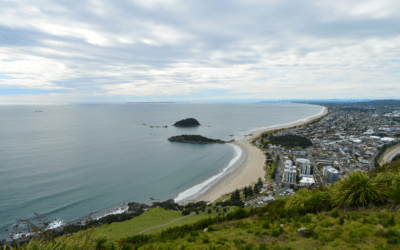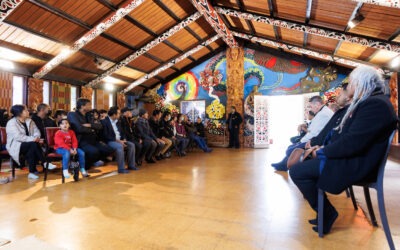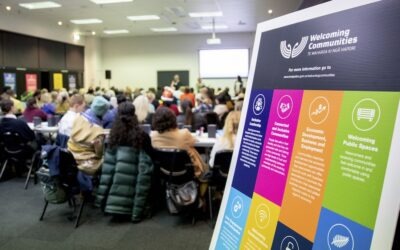Stephanie Velvin
Welcoming Communities Coordinator at the Palmerston North City Council
Q: How do you engage local communities in the culture of welcome?
A: I work with community groups through our Welcoming Communities Advisory Group, which includes representatives of the council and from various local community groups and agencies, such as the Network of Skilled Migrants Manawatū, Manawatū Multicultural Council, and English Language Partners. Regular meetings become an opportunity for members to share information about upcoming events and projects, so we are all aware of these individual efforts and can collectively support them. The Advisory Group meetings have become a popular forum for visitors to attend: we have had guests from the Manawatu Peoples Radio, Te Awa Community Foundation and the PNCC policy team.
One of the projects we have been working on for a while now is Palmy Global Ambassadors. We have a large international students’ community in the city, and they wanted to connect with the rest of our community. The new leadership program brought together local and international students over a shared learning and skill exchange program. They said that the biggest thing that they got out of it were friendships. These young people will grow into successful professionals, global citizens, creating many international opportunities for New Zealand.
Q: What role do Māori culture play in the welcoming process in Palmerston North?
A: We have been supported by the local iwi Rangitāne o Manawatū, who are teaching us about how we can weave the principles of manaakitanga (hospitality) into the way we welcome our new residents. We work alongside local iwi, co-designing activities with them and acknowledging that they were the first to welcome us on this land. Hospitality and welcoming is a really important principle for Māori culture. We have conversations with iwi about how we can work together in a respectful way, elevating the aspirations of Māori and iwi and making sure that we are being open and inclusive to newcomers.
So for example, in our City Welcome Sessions, which are our flagship activities, we have supported local iwi to grow a youth Kapa Haka performance group. They perform Pōwhiri, which is the formal Māori welcome during our Welcome sessions. Some of the newcomers told us that they’ve been here for several months but this was their first interaction with Māori culture.
It’s important to emphasize that Pōwhiri starts at the door, people are physically welcomed into the space with gestures and songs. It makes the Welcoming session about a creative and cultural experience and really feeling welcome, rather than something transactional.
Q: What is your approach?
A: We welcome partnerships and we realized the value in creating spaces where people could spend time together and engage in conversations. We don’t really do anything that the cultural group or community group hasn’t asked for, we build on what is already there and work together to replace duplicated efforts with joint efforts. An example where this has worked well is that previously many organizations, such as schools, would invite the mayor and do their own small scale ‘welcome’ events. Now, we host joint Welcome Sessions at the council for the international students twice a year.
Similarly, we identified that migrants coming to live with their families or to work for smaller employers didn’t always get a formal welcome or orientation, which resulted in them not knowing about local opportunities, and there being a potential knowledge gap around local customs. We created a City Welcome Session program, providing regular orientation events to migrants. They were so successful that the Red Cross, who is also part of the Advisory Group, have decided to bring newly arrived refugees to our sessions, rather than trying to organize their own.
We observed that improving access to resources, support, and services, led to an increase in the understanding of local systems and culture. In the long run we know this leads to higher engagement in employment and education, and better outcomes for health and wellbeing.
I work alongside The Multicultural Liaison Officer to implement the Welcoming Communities program and to make it more manageable. We also work with the Multicultural Council. I think that’s why the program has been really successful here: we are all supporting each other.
Q: Why do community groups and local organizations come onboard the Welcoming Communities program?
A: Community groups are usually under-resourced, they have lots of great ideas, but less time to really hit that strategic phase and build relationships with other networks. The Welcoming Communities coordinator role thus adds value by providing oversight to projects, connecting groups to other partners and facilitating getting a new project going.
The simplicity and clarity of the program is something that resonates with people. A lot of communities and councils would like to become more welcoming, but they don’t have a framework for that. They don’t know how to talk about racism and xenophobia with their communities. They might have refugees arriving in their regions for the first time, and they don’t know how to address this with local residents. The Welcoming Communities program helps facilitate these conversations, and we have resources that clearly explain ‘this is what a welcoming community looks like and this is how to get there’. Using the term ‘newcomers’ takes away biases that people might have when talking about refugees or migrants.
Q: How are you supported by Immigration New Zealand?
A: To be able to pick up the phone and talk to a dedicated Refugee & Migrant Support team member in Wellington, whom I can contact anytime, is a great support. Immigration New Zealand has developed lots of useful resources for the coordinators, and they continue to do so. It’s very useful for me, in terms of showing the legitimacy of the program, to see our stories and successes published online, demonstrating what we’re doing in Palmerston North.
Q: What is your favorite story of impact?
A: Some of the most visible stuff that we do here is supporting cultural groups to celebrate various festivals throughout the year. These festivals would be countrywide celebrations where they came from, but here they would be celebrated in private homes or small venues — invisible to other communities. We supported some of the local community groups to get out and celebrate in public spaces and connect with the wider community.
We worked alongside the Hindu community for months in the lead up to Diwali, and this was the first time it was celebrated as a public family event. They were beyond grateful that the council was making the time and effort to acknowledge that this is a really significant celebration for them. Some community groups had wanted to do this for over ten years. Having the Welcoming Communities framework and resources allowed for them to move forward with it.
In advance of the local government elections in 2019, the council produced a one-page information leaflet in fourteen different languages. These were chosen based on community need, i.e. those most likely to otherwise have low voter turnout or be less likely to have a level of English required to comprehend voting information. We wanted to get any newcomer who’s eligible to vote engaged in the process. These leaflets were primarily distributed through the Welcoming Communities Advisory Group networks, as well as through community leaders, and touch points such as the Library and the Multicultural Center. A lot of what we do is hard to measure, so the very positive feedback we got from the community meant a lot to us. Many noted that they particularly appreciated the gesture of council making a real effort to be inclusive in their civic engagement.



